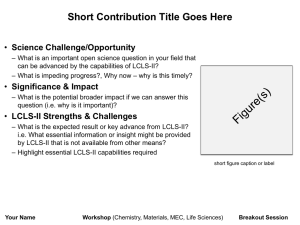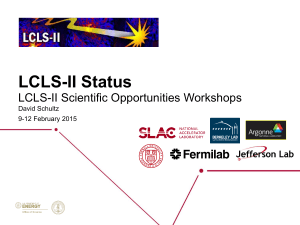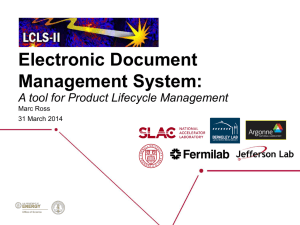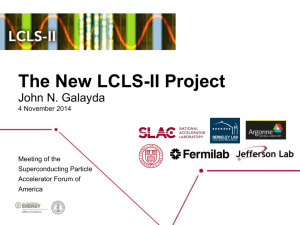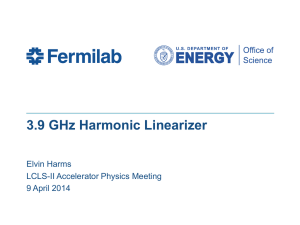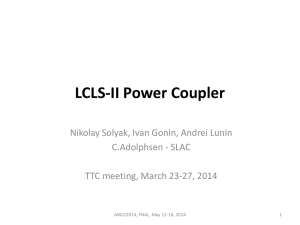Schlotter_Intro_workshop_v4_MP
advertisement
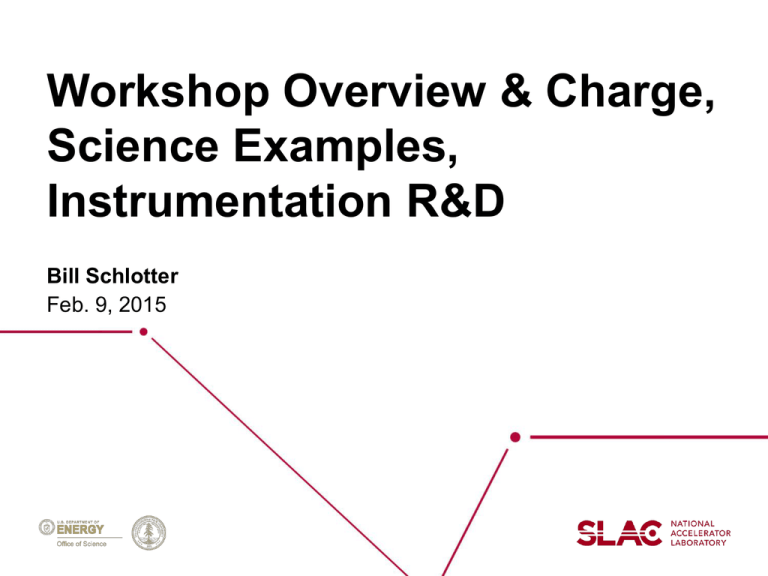
Workshop Overview & Charge, Science Examples, Instrumentation R&D Bill Schlotter Feb. 9, 2015 Outline Workshop Charge Workshop Format Breakout activities Scientific Opportunity Example From workshops to transformational science at LCLS-II Planning for Instruments at LCLS-II LCLS-II Scientific Opportunities Workshop, Feb. 2015 Our Charge LCLS-II Scientific Opportunities Workshop, Feb. 2015 Ensuring LCLS-II will be useful for our science The strength of the Scientific Opportunities we develop and refine over the next two days will guide the capabilities developed for LCLS-II X-ray Parameters Instrumentation Methods Our workshop will form the basis for a document describing the most important Scientific Opportunities at LCLS-II. Our workshop will inform the instrumentation developed for LCLS-II LCLS-II Scientific Opportunities Workshop, Feb. 2015 Workshop Charge (Identifying Science) To identify the most important science opportunities (transformational, grand challenge level) that can uniquely be addressed using capabilities of LCLS-II (high rep rate <5 keV, 1-25 keV at 120 Hz) Near-term science consistent with LCLS-II baseline Future science consistent with potential LCLS-II upgrades Succinct statement of why this science is transformational What are important outstanding questions in your field? Why have they not been answered (what is impeding progress, why now, why LCLS-II)? What is the potential broader impact if we can answer these questions (why are they important)? Plenary speakers will outline selected important science areas setting the stage for the breakout discussions. LCLS-II Scientific Opportunities Workshop, Feb. 2015 Workshop Charge (Experiments, Parameters, Alternatives?) Map out experimental approach and key requirements for: Beamline optics, endstation(s), detectors, lasers, sample injectors etc. Identify key capabilities, consistent with nominal LCLS-II baseline (and upgrades – secondary) Photon flux, pulse duration, rep rate, tuning, polarization, etc. Compare experimental approach to current state-of-the art & assess alternative approaches Can the experimental approach leverage existing instrumentation/expertise? What R&D is required? Can the science be done with other existing sources? (e.g. diffraction-limited synchrotrons, table-top HHG, etc.) Breakout sessions will identify priority science opportunities linked to LCLS-II & outline experimental approaches and parameters LCLS-II Scientific Opportunities Workshop, Feb. 2015 Workshop Format LCLS-II Scientific Opportunities Workshop, Feb. 2015 Material Physics Workshop Format Day 1 (Monday) Day 2 (Tuesday) Morning: Morning: Introduction Plenary Speakers Plenary Speakers Breakout Sessions Afternoon: Afternoon: Lunch Lunch Plenary Speakers Breakout Sessions Breakout Sessions Breakout Closeout Dinner Depart Homework LCLS-II Scientific Opportunities Workshop, Feb. 2015 Breakouts: All are encouraged to present ideas – template provided Each breakout will deliver a summary at the closeout session Scribes will take notes and collect presented materials for internal use only. Breakout List Topics Co-Leaders Magnetism & spin dynamics Hermann Durr, Peter Fischer Correlated materials & charge-collective modes Z.X. Shen, Tom Devereaux, Zahid Hussain Materials physics – nanoscale structure, domains, grain boundaries Aymeric Robert, David Reis, Steve Kevan Each breakout will be introduced in more detail this afternoon LCLS-II Scientific Opportunities Workshop, Feb. 2015 Breakout Contribution Template • Everyone is encouraged to contribute a scientific opportunity for LCLS-II • Template slides provide a guide for input. • It’s not to late to start! LCLS-II Scientific Opportunities Workshop, Feb. 2015 Breakout Deliverables • Summary slides for closeout that address the charge • Written notes addressing the charge with respect to scientific impact and relevance to LCLS-II • Answers to the LCLS-II parameters questions • Notes from breakout discussion (scribe) • Collection of slides (on a memory stick) presented at the breakout. (scribe) LCLS-II Scientific Opportunities Workshop, Feb. 2015 Breakout discussion FAQ Q: LCLS-II sounds great, but it can’t answer the most important questions in my field...should I go home? A: You should stay. Focus on the key pieces where LCLS-II can provide unique insight. Q: I have this great idea, but it requires 10fs synchronization between the optical and x-ray pulses, and the spec is <20fs. A: Requirements outside of the nominal should provide a clearly justified scientific opportunity. Develop meaningful scientific advances starting with <20 fs (nominal) synchronization and working toward the target synchronization. Q: I can do my experiment at LCLS today. At LCLS-II, I would do the same thing just a 1000 time faster. Is that really unique? A: It depends, but if you need one year of LCLS-I beamtime—which you obviously can’t get—to make progress on your experiment and one shift at LCLS-II would do the same then YES that is unique. LCLS-II Scientific Opportunities Workshop, Feb. 2015 Build from previous work! 2012 SLAC/LBNL 2008 BES 2009 2007 Document are available on the workshop website LCLS-II Scientific Opportunities Workshop, Feb. 2015 2012 2009 2009 2010 Scientific Opportunity An Example LCLS-II Scientific Opportunities Workshop, Feb. 2015 Understanding Multi-electron Photo-Catalytic Systems Science Challenge/Opportunity Important “grand challenge level” scientific question • Understanding natural and artificial photo-catalysts on natural time scales and under operating conditions • Critically missing is a complete characterization of the electronic and atomic structure of rare/transient intermediate states responsible for key steps in catalysis (e.g. water splitting) O2 S0 S1 hn e- hn S4 Significance & Impact • Deeper understanding of natural photo-catalysts is essential to design efficient, robust, chemically selective catalytic systems from earth-abundant elements • Optimization of artificial systems requires characterization of their dynamics under operating conditions Challenges & LCLS-II Strengths H+, e- hn hn H+, e- S3 S2 H+, e- LCLS-II connection • Sub-nm resolution, chemical specificity, dynamics. O2 Evolving Catalyst • Tunable ultrafast soft X-rays at high rep rate will enable Mn4CaO5 chemically-specific characterization of rare transient intermediate states (occupied, unoccupied and collective states) 4-photon, 4-electron catalyst with dynamics Baseline and future via time-resolved RIXS. spanning sub-psec to msec. Critical S4 state is metastable and has eluded characterization • Two-color, tailored laser excitation, wet RIXS endstation upgrade with present methods/sources. LCLS-II Scientific Opportunities Workshop, Feb. 2015 Your Name Workshop (Chemistry, Materials, life Sciences) Breakout Session Experimental Approach Time resolved RIXS, two1MLCT color spectroscopy…. 3MLCT • Techniques(s) – Dynamic electronic structure of transition-metal catalysts. Chemical specificity to transition-metal and ligand(s) – Time-resolved RIXS, two-color spectroscopy, stimulated Raman, multidimensional spectroscopy DE hνout • Tools N-1s • Alternatives – Synchrotron approaches rely on largely static measurements of crytrapped states. Not all intermediates can be cryo-trapped, and fixed samples are susceptible to damage as significant accumulated photons are required. energy loss (eV) – High-resolution (100 meV), high-throughput RIXS spectrometer for solution-phase samples (jets or droplets for shot-to-shot sample Resonant Inelastic X-ray Scattering replacement. Suitable designs are presently available that represent (RIXS, X-ray Raman) Specific and quantitative • Occupied & unoccupied states a modest advance beyond current instruments. transfer parameter•• Charge requirements – Two-color and multidimensional spectroscopy requires Multi-particle excitations independently tunable pulses from FEL (DE ~0-500 eV), and optics for manipulating them. incident energy (eV) Alternatives discussion LCLS-II Scientific Opportunities Workshop, Feb. 2015 Your Name Take Credit! static N K-edge RIXS map - So (BESSY – Wernet, Huse et al.) From this workshop Through instrumentation To important science at LCLS-II LCLS-II Scientific Opportunities Workshop, Feb. 2015 Toward Science at LCLS-II … Delivering effective capabilities for science requires parallel effort Science • Scientific opportunities are identified through the workshop, and through ongoing activities of science working groups, and captured in a science document R&D • R&D and planning for LCLS-II instrumentation is ongoing at the LCLS facility, and will be guided and prioritized in large part by science opportunities and needs identified for LCLS-II LCLS-II • LCLS-II beam parameters are optimized by the LCLS-II project with guidance from scientific drivers. LCLS-II Scientific Opportunities Workshop, Feb. 2015 Input for R&D • The LCLS operating facility will guide instrumentation for LCLS-II. R&D is underway in many areas • • • • X-ray Detectors Pump Lasers Data Acquisition Sample Delivery • LCLS-II accelerator parameters being developed and priorities • Bi-weekly discussion between with LCLS & LCLSII to inform and drive progress in these areas. LCLS-II Scientific Opportunities Workshop, Feb. 2015 • • Polarization Control Seeding LCLS-II & Instrumentation LCLS-II Scientific Opportunities Workshop, Feb. 2015 LCLS-II Operating Facility Layout FEH NEH Cu Linac H4 H4.5 H3 H1 0.25-1.3 keV (120kW) H4 H2 4 GeV, 0.3 mA, 1.2MW H3 H4.5 H5 • Polarization currently under evaluation • Soft x-ray undulator is linear horizontal. Option for elliptical polarization control requires strong scientific support • Hard x-ray undulator has option for either linear vertical or linear horizontal. LCLS-II Scientific Opportunities Workshop, Feb. 2015 H6 FEH NEH SC Linac H5 H6 Soft x-ray instrumentation at LCLS-II As part of the LCLS-II project , a single soft x-ray beamline (200eV-1250eV) will be built. The current soft x-ray beamlines in hutches 1 and 2 will be removed. Scientific opportunities will drive additional instrumentation Monochromatic beamline High resolution x-ray emission spectrometers Reaction-microscope system Pulsed magnetic field systems Upgraded or new end station systems LCLS-II Scientific Opportunities Workshop, Feb. 2015 Instrumentation plan for LCLS-II Space for instruments at LCLS-II is constrained by the layout of the Near and Far Experiment Halls. Significant reconfiguration and development of the NEH instruments is expected. Control Rooms Future Instrument Space LCLS-II Scientific Opportunities Workshop, Feb. 2015 Future Instrument Space Hard x-ray instrumentation The hard x-ray instruments will remain in the same location for LCLS-II with ancillary upgrades necessary for LCLS-II compatibility All four hard x-ray instruments can use the LCLS-II beam XPP, XCS and MEC can operate at photon energies as high as 25keV at lower repetition rates because a mirror upgrade project that is currently underway. Because of a mirror upgrade the CXI instrument will be capable of delivering focused beam at higher repetition rate. Future detector, pump laser and DAQ upgrade options are part of the current LCLS facility development. LCLS-II Scientific Opportunities Workshop, Feb. 2015 Summary We are charged to develop important science opportunities unique to LCLS-II at the startup of LCLS-II and beyond. Breakout group deliverables will develop into the Scientific Opportunities Document The R&D on instrumentation at LCLS along with the development of the LCLS-II project are underway in parallel—now is the time to begin refining the instrumentation plan. LCLS-II Scientific Opportunities Workshop, Feb. 2015 Questions & Discussion LCLS-II Scientific Opportunities Workshop, Feb. 2015 END LCLS-II Scientific Opportunities Workshop, Feb. 2015
